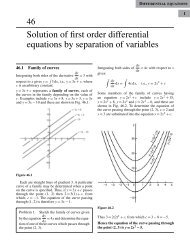integration
Create successful ePaper yourself
Turn your PDF publications into a flip-book with our unique Google optimized e-Paper software.
382 INTEGRAL CALCULUS<br />
When area PQRS is rotated about axis XX the volume<br />
generated is that of the pulley. The centroid of<br />
the semicircular area removed is at a distance of 4r<br />
3π<br />
from its diameter (see ‘Engineering Mathematics 4th<br />
edition’, page 471), i.e. 4(1.0) , i.e. 0.424 cm from<br />
3π<br />
PQ. Thus the distance of the centroid from XX is<br />
5.0 − 0.424, i.e. 4.576 cm.<br />
The distance moved through in one revolution by the<br />
centroid is 2π(4.576) cm.<br />
Area of semicircle = πr2<br />
2 = π(1.0)2<br />
2<br />
By the theorem of Pappus,<br />
= π 2 cm2<br />
volume generated ( = area × distance moved by<br />
π<br />
)<br />
centroid = (2π)(4.576).<br />
2<br />
i.e. volume of metal removed = 45.16 cm 3<br />
Mass of metal removed = density × volume<br />
= 8000 kg m −3 × 45.16<br />
10 6 m3<br />
= 0.3613 kg or 361.3g<br />
volume of pulley = volume of cylindrical disc<br />
− volume of metal removed<br />
= π(5.0) 2 (2.0) − 45.16<br />
= 111.9 cm 3<br />
Mass of pulley = density × volume<br />
= 8000 kg m −3 × 111.9<br />
10 6 m3<br />
= 0.8952 kg or 895.2 g<br />
Now try the following exercise.<br />
Exercise 152 Further problems on the theorem<br />
of Pappus<br />
1. A right angled isosceles triangle having a<br />
hypotenuse of 8 cm is revolved one revolution<br />
about one of its equal sides as axis. Determine<br />
the volume of the solid generated using<br />
Pappus’ theorem. [189.6 cm 3 ]<br />
2. Using (a) the theorem of Pappus, and (b) <strong>integration</strong>,<br />
determine the position of the centroid<br />
of a metal template in the form of a quadrant<br />
of a circle of radius 4 cm. (The equation of a<br />
circle, centre 0, radius r is x 2 + y 2 = r 2 ).<br />
⎡<br />
⎤<br />
On the centre line, distance<br />
2.40 cm from the centre, ⎥<br />
i.e. at co-ordinates ⎦<br />
(1.70, 1.70)<br />
⎢<br />
⎣<br />
3.(a) Determine the area bounded by the curve<br />
y = 5x 2 , the x-axis and the ordinates<br />
x = 0 and x = 3.<br />
(b) If this area is revolved 360 ◦ about (i) the<br />
x-axis, and (ii) the y-axis, find the volumes<br />
of the solids of revolution produced<br />
in each case.<br />
(c) Determine the co-ordinates of the centroid<br />
of the area using (i) integral calculus,<br />
and (ii) the theorem of Pappus.<br />
⎡<br />
⎤<br />
(a) 45 square units<br />
⎢(b) (i) 1215π cubic units ⎥<br />
⎣ (ii) 202.5π cubic units⎦<br />
(c) (2.25, 13.5)<br />
4. A metal disc has a radius of 7.0 cm and is<br />
of thickness 2.5 cm. A semicircular groove of<br />
diameter 2.0 cm is machined centrally around<br />
the rim to form a pulley. Determine the volume<br />
of metal removed using Pappus’theorem<br />
and express this as a percentage of the original<br />
volume of the disc. Find also the mass of<br />
metal removed if the density of the metal is<br />
7800 kg m −3 .<br />
[64.90 cm 3 , 16.86%, 506.2 g]<br />
For more on areas, mean and r.m.s. values, volumes<br />
and centroids, see ‘Engineering Mathematics 4th<br />
edition’, Chapters 54 to 57.<br />
38.7 Second moments of area of<br />
regular sections<br />
The first moment of area about a fixed axis of a<br />
lamina of area A, perpendicular distance y from the<br />
centroid of the lamina is defined as Ay cubic units.<br />
The second moment of area of the same lamina as<br />
above is given by Ay 2 , i.e. the perpendicular distance










